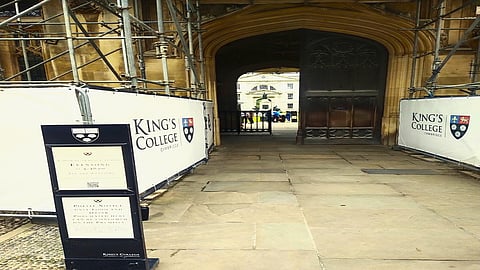

#Ajayan
Cambridge conjures images of the illustrious university, alma mater to countless luminaries. Over 30 colleges grace the city, each etched in history. At King's College, minds like Isaac Newton, Charles Darwin, Niels Bohr, Stephen Hawking, Florence Nightingale, Thomas Hardy, John Keats and Indian economist PC Mahalanobis once roamed. Trinity College boasts names such as Francis Bacon, Srinivasa Ramanujan, Jawaharlal Nehru, his grandson Rajiv Gandhi and cricket legend Ranjitsinhji. St John’s College can claim William Wordsworth and Manmohan Singh among its notable alumni. As one strolls through the streets of this educational haven, the long list of distinguished scholars and the colleges around leaves one in awe.
The massive structures with the heavy wooden doors, now modernized with electronic entry via identity card swipes, retain an aura of antiquity. The air around is thick with the whispers of the past and the streets surrounding them buzz with tourists from across the globe, drawn to the timeless charm of Cambridge. At street corners, there is a tapestry of art and craft items, inviting passersby to pause and admire the vibrant expressions of artistry, adding a touch of whimsy and charm to the historical place.
Cambridge's storied history in education began with Peterhouse, its first college, established in 1284, and extends to Robinson, the newest addition, founded in 1977. Among the 31 colleges nestled in this quaint town, some are exclusively for postgraduates. The Gothic architecture of these venerable institutions has inspired numerous American universities.
Newton and the apple tree
Outside Trinity College stands the "Flower of Kent" apple tree, a living tribute to its illustrious alumnus, Isaac Newton. This tree, grafted from the original at Newton's childhood home in Woolsthorpe Manor, Lincolnshire, was planted in 1954. Legend holds that Newton's theory of universal gravitation, published in the historic "Principia" in 1687, was inspired by the fall of an apple from a tree. Newton joined Trinity in 1661 but returned home for a few years during the Bubonic Plague outbreak. It was during this period of seclusion that the fateful apple is said to have fallen as he rested beneath the tree, sparking a revelation that would change the course of science.
A large crowd gathers to admire and photograph this historic tree from a respectful distance. Some visitors even leave an apple at its base, a humble tribute to the great scientist whose insight beneath the boughs of the original tree reshaped our understanding of the universe.
The oldest church
The ancient Benet’s Church, dating back to 1020, stands as another captivating tourist attraction, celebrated as the oldest church in Great Britain. Closely tied to Corpus Christi College, established in 1352, historical documents reveal an intriguing agreement: the rector consented to ring the church bells for the university in exchange for an annual 'customary gratification'.
Another enchanting landmark in Cambridge is the Church of the Holy Sepulchre, affectionately known as the Round Church. Constructed around 1130, this Anglican church's unique circular design is believed to have been inspired by the rotunda of the Holy Sepulchre Church in Jerusalem.
Mathematical Bridge
One of Cambridge's most iconic landmarks is the Mathematical Bridge, spanning the Cam River beside Queens' College. Constructed in 1749 from oak wood, this bridge is renowned for its distinctive design. It underwent reconstruction in 1866 and 1905 due to weathering.
The Mathematical Bridge is steeped in myth and legend, with tales suggesting a connection to Isaac Newton. Allegedly designed by scientist himself, the bridge was constructed 23 years after his passing, with its joints originally devoid of any connections. A popular story recounts how ambitious students, aided by their tutors, attempted to disassemble the bridge to uncover its construction secrets, only to find themselves unable to reassemble it in its original form. As a result, bolts were used to restore the bridge to its former glory.
The first Indian Mayor
The surge of students from India, particularly Kerala, flocking to the UK in pursuit of education and employment, has brought its share of troubles. Baiju Thittala, the first Indian to serve as the Mayor of Cambridge, voices his concerns about their plight. Since taking office in May, Baiju has been inundated with complaints from these students, who call him daily, struggling to find adequate accommodation. He told Metro Vaartha that in most cases, the blame lies with recruiting agencies in Kerala, which fill students with false hopes and promises. Many are left to endure cramped, dimly lit basements, with barely any light or air, casting long shadows over their dreams.
Beyond the challenges faced by students, the spectre of extreme poverty looms over Cambridge, notes Baiju. The city ranks among the top in Great Britain for its stark divide and inequality. The number of homeless individuals is staggering. A jarring contrast to Cambridge's global reputation as a beacon of education is that access to quality education remains a distant dream for the majority. Baiju's foremost priority is to secure funding to address these pressing issues in a town that, despite its status as a business hub, has traditionally catered only to the elite.
